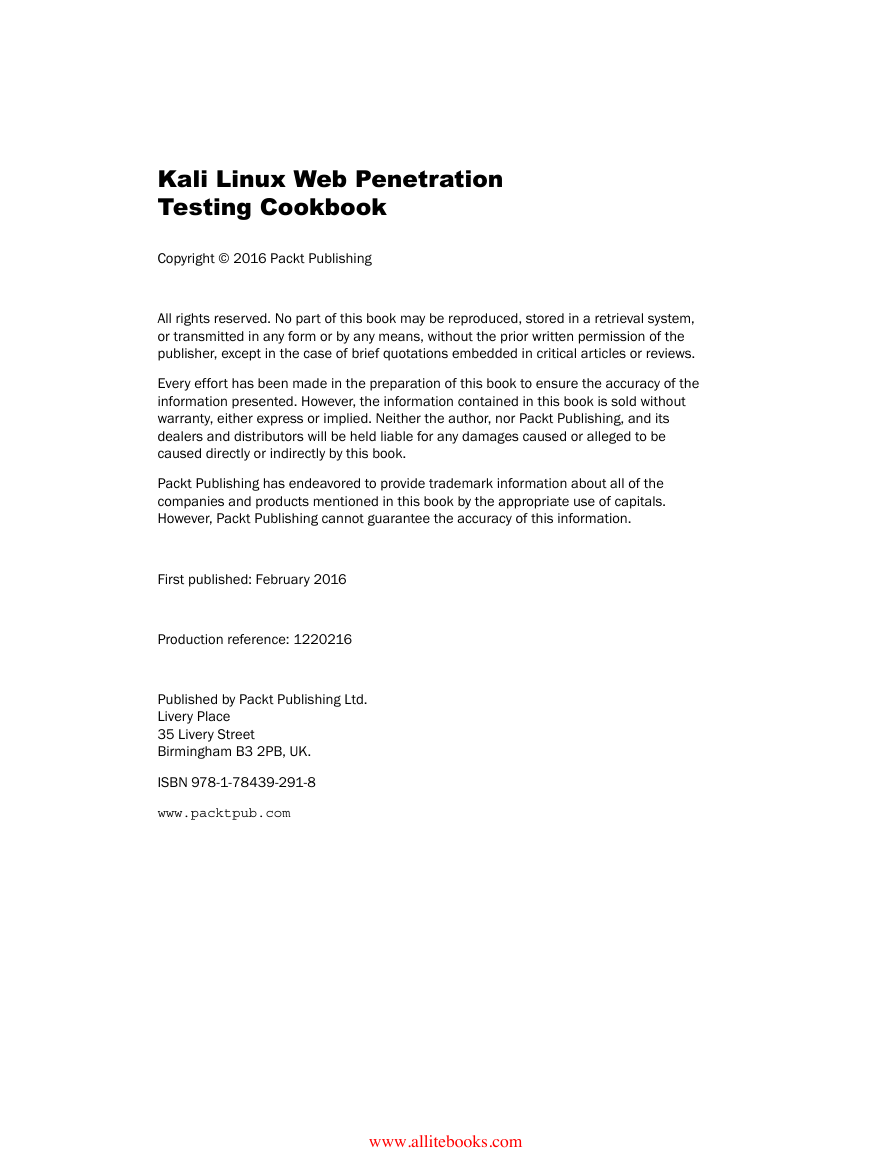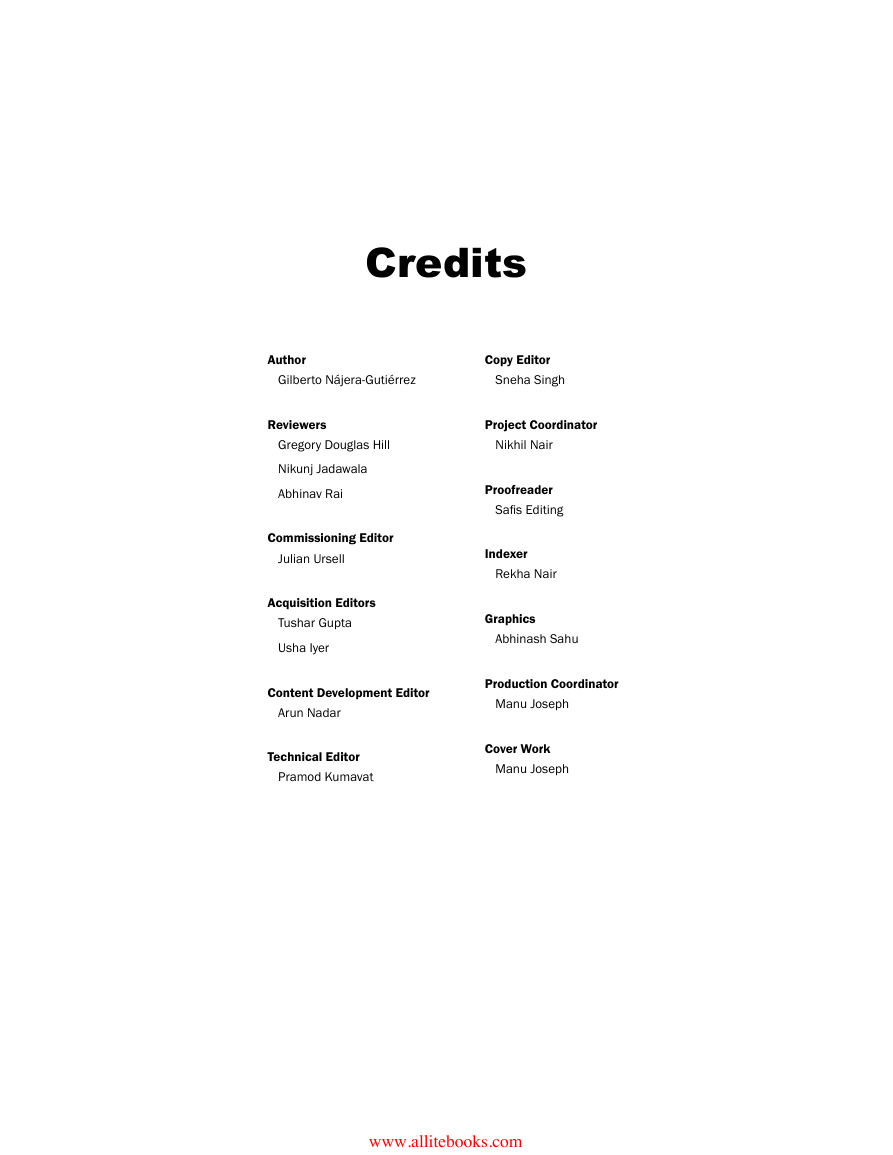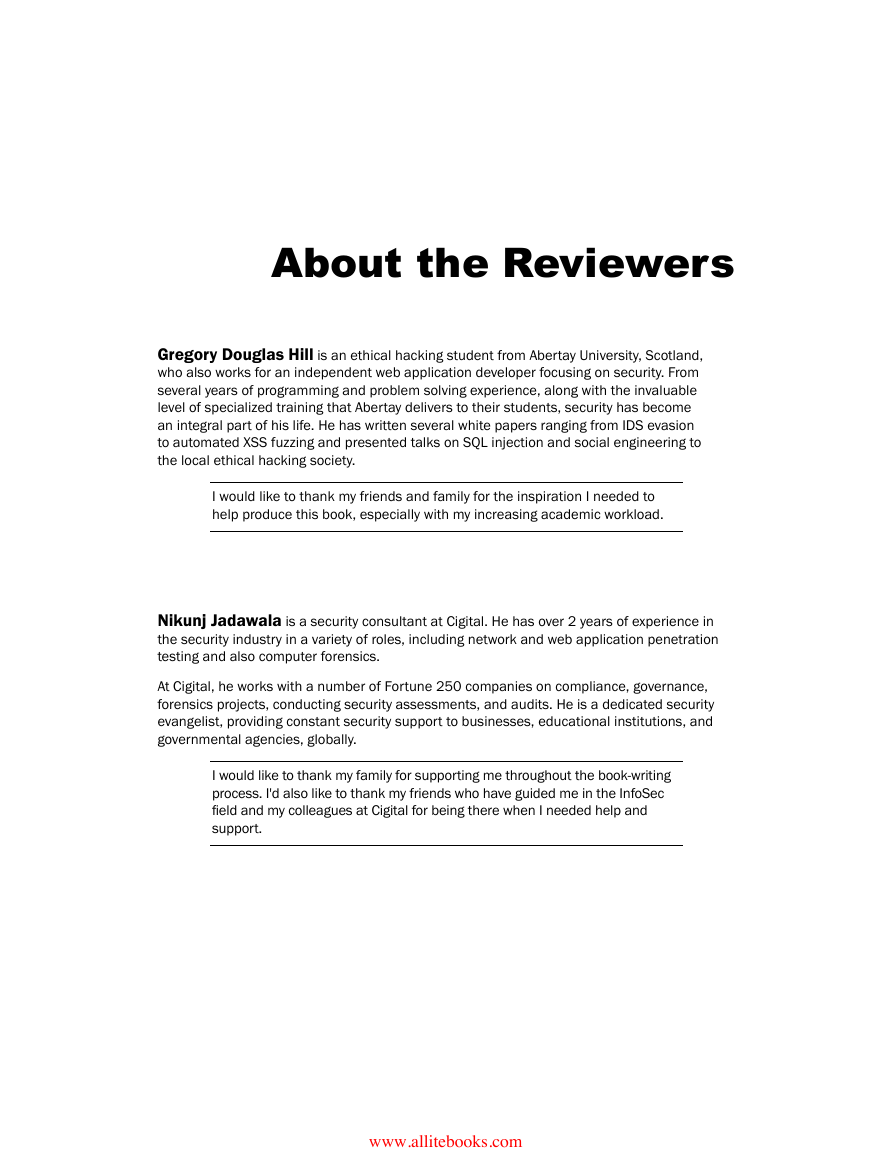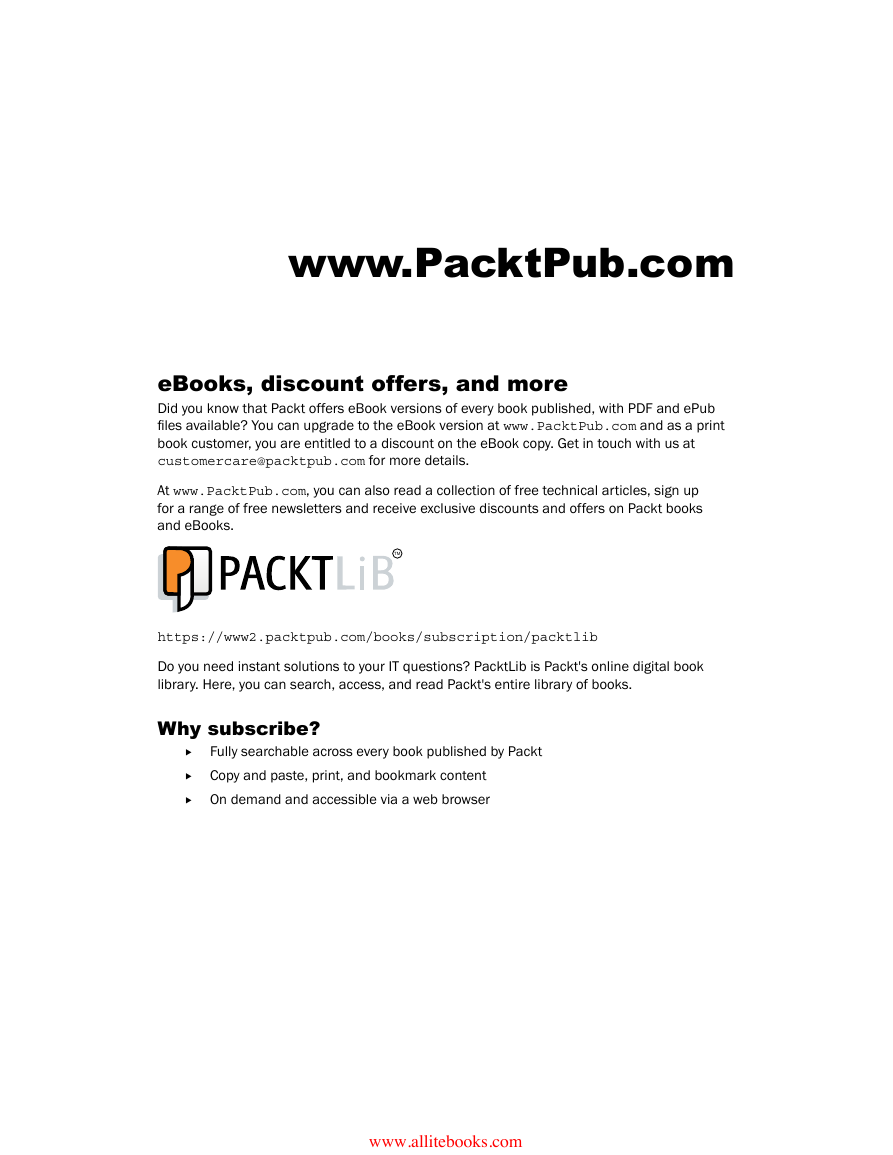Cover
Copyright
Credits
About the Author
About the Reviewers
www.PacktPub.com
Table of Contents
Preface
Chapter 1: Setting Up Kali Linux
Introduction
Updating and upgrading Kali Linux
Installing and running OWASP Mantra
Setting up the Iceweasel browser
Installing VirtualBox
Creating a vulnerable virtual machine
Creating a client virtual machine
Configuring virtual machines for correct communication
Getting to know web applications on a vulnerable VM
Chapter 2: Reconnaissance
Introduction
Scanning and identifying services with Nmap
Identifying a web application firewall
Watching the source code
Using Firebug to analyze and alter
basic behavior
Obtaining and modifying cookies
Taking advantage of robots.txt
Finding files and folders with DirBuster
Password profiling with CeWL
Using John the Ripper to generate
a dictionary
Finding files and folders with ZAP
Chapter 3: Crawlers and Spiders
Introduction
Downloading a page for offline analysis
with Wget
Downloading the page for offline analysis with HTTrack
Using ZAP's spider
Using Burp Suite to crawl a website
Repeating requests with Burp's repeater
Using WebScarab
Identifying relevant files and directories from crawling results
Chapter 4: Finding Vulnerabilities
Introduction
Using Hackbar add-on to ease parameter probing
Using Tamper Data add-on to intercept and modify requests
Using ZAP to view and alter requests
Using Burp Suite to view and alter requests
Identifying cross-site scripting (XSS) vulnerabilities
Identifying error based SQL injection
Identifying a blind SQL Injection
Identifying vulnerabilities in cookies
Obtaining SSL and TLS information
with SSLScan
Looking for file inclusions
Identifying POODLE vulnerability
Chapter 5: Automated Scanners
Introduction
Scanning with Nikto
Finding vulnerabilities with Wapiti
Using OWASP ZAP to scan for vulnerabilities
Scanning with w3af
Using Vega scanner
Finding Web vulnerabilities with
Metasploit's Wmap
Chapter 6: Exploitation – Low Hanging Fruits
Introduction
Abusing file inclusions and uploads
Exploiting OS Command Injections
Exploiting an XML External Entity Injection
Brute-forcing passwords with THC-Hydra
Dictionary attacks on login pages with Burp Suite
Obtaining session cookies through XSS
Step by step basic SQL Injection
Finding and exploiting SQL Injections with SQLMap
Attacking Tomcat's passwords with Metasploit
Using Tomcat Manager to execute code
Chapter 7: Advanced Exploitation
Introduction
Searching Exploit-DB for a web server's vulnerabilities
Exploiting Heartbleed vulnerability
Exploiting XSS with BeEF
Exploiting a Blind SQLi
Using SQLMap to get database information
Performing a cross-site request forgery attack
Executing commands with Shellshock
Cracking password hashes with John the Ripper by using a dictionary
Cracking password hashes by brute force using oclHashcat/cudaHashcat
Chapter 8: Man in the
Middle Attacks
Introduction
Setting up a spoofing attack with Ettercap
Being the MITM and capturing traffic
with Wireshark
Modifying data between the server and
the client
Setting up an SSL MITM attack
Obtaining SSL data with SSLsplit
Performing DNS spoofing and redirecting traffic
Chapter 9: Client-Side Attacks and Social Engineering
Introduction
Creating a password harvester with SET
Using previously saved pages to create a phishing site
Creating a reverse shell with Metasploit and capturing its connections
Using Metasploit's browser_autpwn2 to attack a client
Attacking with BeEF
Tricking the user to go to our fake site
Chapter 10: Mitigation of OWASP Top 10
Introduction
A1 – Preventing injection attacks
A2 – Building proper authentication and session management
A3 – Preventing cross-site scripting
A4 – Preventing Insecure Direct Object References
A5 – Basic security configuration guide
A6 – Protecting sensitive data
A7 – Ensuring function level access control
A8 – Preventing CSRF
A9 – Where to look for known vulnerabilities on third-party components
A10 – Redirect validation
Index
















 2023年江西萍乡中考道德与法治真题及答案.doc
2023年江西萍乡中考道德与法治真题及答案.doc 2012年重庆南川中考生物真题及答案.doc
2012年重庆南川中考生物真题及答案.doc 2013年江西师范大学地理学综合及文艺理论基础考研真题.doc
2013年江西师范大学地理学综合及文艺理论基础考研真题.doc 2020年四川甘孜小升初语文真题及答案I卷.doc
2020年四川甘孜小升初语文真题及答案I卷.doc 2020年注册岩土工程师专业基础考试真题及答案.doc
2020年注册岩土工程师专业基础考试真题及答案.doc 2023-2024学年福建省厦门市九年级上学期数学月考试题及答案.doc
2023-2024学年福建省厦门市九年级上学期数学月考试题及答案.doc 2021-2022学年辽宁省沈阳市大东区九年级上学期语文期末试题及答案.doc
2021-2022学年辽宁省沈阳市大东区九年级上学期语文期末试题及答案.doc 2022-2023学年北京东城区初三第一学期物理期末试卷及答案.doc
2022-2023学年北京东城区初三第一学期物理期末试卷及答案.doc 2018上半年江西教师资格初中地理学科知识与教学能力真题及答案.doc
2018上半年江西教师资格初中地理学科知识与教学能力真题及答案.doc 2012年河北国家公务员申论考试真题及答案-省级.doc
2012年河北国家公务员申论考试真题及答案-省级.doc 2020-2021学年江苏省扬州市江都区邵樊片九年级上学期数学第一次质量检测试题及答案.doc
2020-2021学年江苏省扬州市江都区邵樊片九年级上学期数学第一次质量检测试题及答案.doc 2022下半年黑龙江教师资格证中学综合素质真题及答案.doc
2022下半年黑龙江教师资格证中学综合素质真题及答案.doc